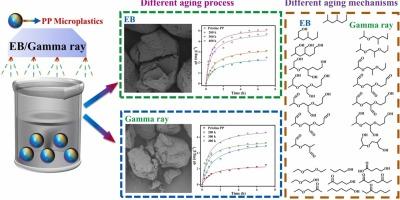聚丙烯微塑料的不同老化途径:电离辐射诱导含氧官能团控制污染物吸附
IF 11.3
1区 环境科学与生态学
Q1 ENGINEERING, ENVIRONMENTAL
引用次数: 0
摘要
传统的处理微塑料的方法往往是不完整和不充分的,这使得阐明微塑料的老化过程和机制具有挑战性。我们采用辐照技术建立了一个高效的氧化体系,在短时间内实现聚丙烯微塑料的完全老化。结果表明,伽马射线具有很强的微塑料降解能力,质量损失达70.58%。此外,在不同的辐照条件下观察到不同的老化机制,证实了微塑料的老化过程受系统氧化能力的影响。随着氧化强度的变化,含氧官能团的生成和转化顺序也发生变化。具体来说,伽马射线最初形成醚键,随后产生羰基和羟基;相比之下,电子束在其他官能团出现之前,主要通过C-H键裂解诱导羟基形成。实验进一步确定了老化和吸附过程中羰基是吸附和转化的主要位点。由于伽马射线优先产生羰基官能团,它显著提高了聚丙烯微塑料的吸附性能和老化程度。我们的发现为理解微塑料的老化和吸附行为提供了新的见解和基础。本文章由计算机程序翻译,如有差异,请以英文原文为准。

Divergent aging pathways in polypropylene microplastics: Ionizing radiation induced oxygen containing functional groups govern pollutant adsorption
Conventional approaches for treating microplastics are often characterized as incomplete and insufficient, rendering it challenging to elucidate the aging processes and mechanisms of microplastics. We employed irradiation technology to establish a highly potent oxidation system that achieves complete aging of polypropylene microplastics within a short timeframe. The results demonstrate that gamma ray exhibits remarkably strong microplastics degradation capability, with a mass loss reaching 70.58 %. Moreover, distinct aging mechanisms were observed under varying irradiation conditions, confirming that the aging process of microplastics is influenced by the oxidative capacity of the system. As the oxidative strength changes, the generation and transformation sequence of oxygen-containing functional groups also varies. Specifically, gamma ray initially forms ether bonds, followed by the generation of carbonyl and hydroxyl groups; in contrast, electron beam induces hydroxyl formation primarily through C–H bond cleavage before the emergence of other functional groups. The experiments further identified carbonyl groups as the principal sites for adsorption and transformation during the aging and adsorption processes. Because gamma ray preferentially produces carbonyl functionalities, it significantly enhances both the adsorption performance and the aging degree of polypropylene microplastics. Our findings provide new insights and foundation for understanding the aging and adsorption behaviors of microplastics.
求助全文
通过发布文献求助,成功后即可免费获取论文全文。
去求助
来源期刊

Journal of Hazardous Materials
工程技术-工程:环境
CiteScore
25.40
自引率
5.90%
发文量
3059
审稿时长
58 days
期刊介绍:
The Journal of Hazardous Materials serves as a global platform for promoting cutting-edge research in the field of Environmental Science and Engineering. Our publication features a wide range of articles, including full-length research papers, review articles, and perspectives, with the aim of enhancing our understanding of the dangers and risks associated with various materials concerning public health and the environment. It is important to note that the term "environmental contaminants" refers specifically to substances that pose hazardous effects through contamination, while excluding those that do not have such impacts on the environment or human health. Moreover, we emphasize the distinction between wastes and hazardous materials in order to provide further clarity on the scope of the journal. We have a keen interest in exploring specific compounds and microbial agents that have adverse effects on the environment.
 求助内容:
求助内容: 应助结果提醒方式:
应助结果提醒方式:


